Quality of the Environment in Japan 1993
(2) Present Situation
a. Certification of Minamata Disease
The Certification of sufferers of Minamata Disease in areas along Minamata Bay as of the end of December 1992 is as follows:
Kumamoto Prefecture Kagoshima Prefecture
The number of living certified sufferers 881 297
The total number of certified sufferers 1,724 486
under the Relief Law or the Compensation Law
The number of Certified sufferers 44 1
before the enactment of the Relief Law(*)
The number of those who were waiting 2,263 187
for certification
Note: (*) Those who had not been certified because of their death before the enactment of the Relief Law.
The certification of sufferers in the basin of the Agano River (Niigata Minamata Disease) as of the end of December 1992 is as follows:
Niigata Prefecture
The number of living certified sufferers 424
The number of certified suffers under the Relief 685
the Relief Law or the Compensation Law
The number of certified sufferers before the 5
enactment of the Relief Law
The number of those who were waiting for certification 9
It is necessary for Kumamoto and Kagoshima Prefecture to make efforts to speed up certification procedure. In addition to maintain existing system for health examination and screening, it is important to develop a system for those who have not taken health examination because, for example, they live in other prefectures at present, For applicants who live in other prefectures, examination facilities have been established in Nagoya, Osaka and Tokyo, which are outside designated areas.
The official certification of sufferers with Minamata Disease has been made on the basis of medical judgments, and the appropriateness of the criteria for judgment on whether persons suffered from this disease was reconfirmed by a meeting of medical specialists on Minamata Disease in October 1985. Also in the recommendation made by the Central Council for Environmental Pollution Control in Novem- ber 1991 ("On the Ideal for Measures to Cope with Minamata Disease"), no findings came out which would make it necessary to alter the criteria.
b. Medical Treatment Research Program
The Medical Treatment Research Program has been carried out since fiscal 1974.
The Medical Treatment Research Program:
which was designed to subsidize the share in the medical care cost, etc., paid by applicants whose examination and judgment drags on over a long time for certification thereby observing and understanding the changes in their conditions.
c. Studies on Comprehensive Measures
Efforts have been made for the fair relief of sufferers from Minamata Disease under the Compensation Law. There remain, how- ever, health problems for local residents, posing serious social issues.
The Environment Agency had requested advice from the Central Council for Environmental Pollution Control on comprehensive mea- sures to cope with those problems. In November 1991, the council came out with the recommendation entitled "On Future Measures to Cope with Minamata Disease."
In response to this recommendation, the Environment Agency carres out The Comprehensive Measures of Minamata Disease, which consists of a health care project, including mass health screenings, for persons who have possibly been exposed to methyl mercury compound and also a fully subsidized medical care project for medical care and recuperation for persons who have sensory impairment in the extrem- ities.
d. Requests for Reviews of Administrative Dismissal of Applications for Certification of Minamata Disease
The requests for reviews of administrative dismissal of applica- tions for certification with Minamata Disease as of the end of December 1992 are as follows:
under the under the
Relief Law Compensation
Law
Requests for reviews of adminis- 628 cases 671 cases
trative dismissal
Revocation decided 12 6
Rejected 2 2
Dismissed 372 224
Withdrawn 35 65
e. Minamata Disease-Related Lawsuits
The lawsuits filed by organizations of applicants for official certification patients with Minamata Disease are pending at nine courts against the State, Kumamoto prefecture and the responsible companies.
Since September 1990, a reconciliation has been recommended by six courts which are involved in the lawsuits in which damages are demanded in conjunction with Minamata Disease around Minamata Bay. The State has replied to these recommendation that it is difficult to comply with them.
As regards the lawsuit at the Tokyo District Court in which the State, Kumamoto Prefecture and Chisso Co., Ltd. were requested to pay damages, the court ruled that the State and Kumamoto Prefecture were cleared of any liability under the State Liability Law. in February 7 th 1992.
As regards the lawsuit which was in dispute at the Niigata District Court against Showa Denko Co., Ltd. in demand for damage compensation, the court recognized Showa Denko's responsibility for the compensation of damages and declared that the State did not have any liability under the State Liability Law. in March 31 th 1992.
As regards the lawsuit at the Kumamoto District Court in which the State, Kumamoto Prefecture and Chisso Co., Ltd., were requested to pay damages, the court recognized responsibility of Chisso, Co., Ltd., the State, Kumamoto Prefecture for the compensation of damages in March 25 th 1993.
f. Financial Support to Chisso Co., Ltd.
To the people who are certified as the sufferers of Minamata Disease, Chisso Co., Ltd. the polluter, has directly compensated for their health damage. Adhering to the Polluter Pays Principle, giving consider- ation to the necessity to ensure the continuation of the compensation and economic and social stabilization of Minamata-Ashikita region, the government has requested related banking institutions for financial and other support in accordance with the agreement reached by the Cabinet in June 1978 "On Measures to Cope With Minamata Disease," on the one hand, and the system is in effect by which the funds raised by Kumamoto Prefecture Government's loan may be lent to Chisso Co., Ltd. on the other.
This system had expired with compensation payment in fiscal 1990 upon the ministerial deliberation, but it was decided that this system would be continued for yet another three years from 1991. And at the same time the government decided the line of policy from 1991 etc. at the related ministerial conference in December 1990.
g. The National Institute for Minamata Disease
The National Institute for Minamata Disease, established in October 1978 as the nation's sole comprehensive medical research insti- tute on Minamata Disease, is engaged in clinical research, basic research and epidemiological surveys and research for a clarification of the clinical manifestation of Minamata Disease and establishment of therapeutic methodologies. In September 1986, this Institute was designated as a collaborative study center by the World Health Organization(WHO)
9-1-4 Itai-Itai Disease
Itai-Itai Disease was found in the basin of Jintu River in Toyama Prefecture. It was reported to a medical society as a strange disease in October 1955. In 1968, the Ministry of Health and Welfare made an administrative statement that Itai-Itai Disease was initiated by renal dysfunction that was caused by chronic cadmium poisoning, which was followed by osteomalacia. It delivered that pregnancy, breast feeding, changes of internal secretion, aging and shortage of calcium and so on helped osteomalacia develop into Itai-Itai Disease. It stated that the only source cadmium identified was the waste water of Kamioka Mining Plant of Mitsui Mining and Smelting Co., Ltd.
The official certification of sufferers of Itai-Itai Disease as of the end of December 1992 is as follows:
Toyama Prefecture
The number of those certified living sufferers 11
The total number of certified as sufferers under 130
the Relief Law or the Compensation Law
(2) Present State
The health examination continues of 15 people in its designated areas in Toyama Prefecture who require long-term observation in order to observe their progress (as of the end of December 1992).
The requests for a review of the administrative decision under the Compensation Law had been filed with the Pollution Related Health Damage Compensation Grievance Board as of the end of December 1992 are as follows:
Requests for review 7 cases
Revoked 4 cases
Dismissed 3 cases
9-1-5 Chronic Arsenic Poisoning
The outbreak of chronic arsenic poisoning in the Toroku area of Miyazaki Prefecture was reported on the basis of a survey conducted by Miyazaki Prefecture in July 1972. The outbreak of chronic arsenic poisoning in the Sasagatani area of Shimane Prefecture was reported on the basis of survey conducted by Shimane Prefecture. The official certification of sufferers as the end of December 1991 in as followed:
Miyazaki Shimane
Prefecture Prefecture
(Toroku) (Sasagatani)
The number of those certified living 76 6
sufferers
The total number of certified sufferers 142 21
under the Relief Law or Compensation
Law
The requests for a review of the administrative decision under the Compensation Law had been filed with the Pollution Related Health Damage Compensation Grievance Board as of the end of December 1992 are as follows:
Requests for review 67 cases
Revoked decided 7 cases
Dismissed 48 cases
Withdrawn 12 cases
9-2 Surveys and Research on Environmental Health
9-2-1 Adverse health effects of Air Pollution
The following surveys and research are under way: (A) Surveys for the establishment of methodology to periodically and continuously monitor relations between air pollution and its health impacts, and to promptly build an environmental health surveillance system for the formulation of necessary measures. (B) Assessment of relations between localized air pollution and impacts on health as is the case with roadside areas along some arterial roads (C) Assessment of relations between pollinosis and air pollution substances
9-2-2 Research on the adverse health effects of substances (such as Cadmium)
Following are the surveys and the research that the Environment Agency is conducting;
(A) Health surveys of residents in areas with environmental cadmium pollution;
The surveys that the agency conducted so far has found out no Itai-Itai disease patients in any areas other than in the basin of Jintsu River in Toyama Prefecture. Since 1985, the agency has been conducting health surveys of the residents who live in the basin of Jintsu River and had shown some findings at the surveys performed between 1979 and 1984.
(B) Studies of health effects of cadmium
The agency has been conducting researches on the mechanism of Itai-Itai disease and the adverse effects of cadmium on human health. In 1989, it compiled the findings of the study and made the interim report. It continues with the study.
(C) Comprehensive studies on Minamata Disease
Comprehensive studies on the impacts of heavy metals and so forth on human bodies were conducted.
Chapter 10. Settlement of Pollution Disputes and Handling of Pollution Offenses
10-1 Settlement of Pollution Disputes and Grievances About Pollution
10-1-1 Settlement of Pollution Disputes
(1) Framework of Disposition of Pollution Disputes
It is stipulated in the Law Concerning the Settlement of Pollution Disputes that pollution disputes shall be settled by the Conciliation Committee on Environmental Pollution, Etc., an external body of the Prime Minister's Office; the Prefectural Environmental Pollution Screening Commission established by each prefecture; and so forth. The dispute settlement system is outlined in Fig. 10-1-1.
The procedure for the settlement of environmental pollution disputes consists of mediation, arbitration, intercession and ruling. The Conciliation Committee on Environmental Pollution exclusively makes rulings and in so-called serious cases and those cases which require an inter-jurisdictional settlement, and carries out mediation, arbitration and intercession. The Prefectural Environmental Pollution Screening Committee makes mediation, arbitration and intercession for all other types of cases.
Fig. 10-1-1 Scheme of Pollution Dispute Processing System.
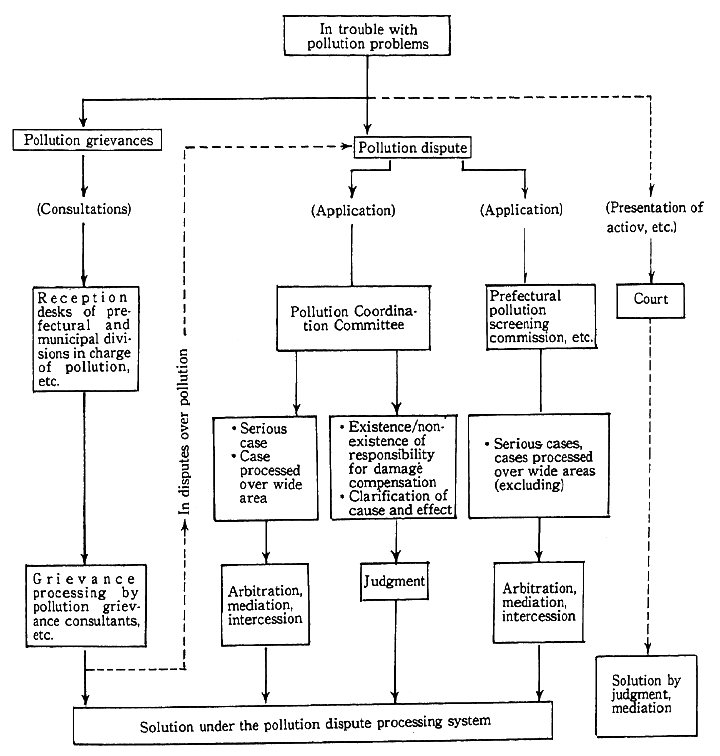
(2) Settlement of Pollution Disputes
a. Cases Pending at the Conciliation Committee on Environmental Pollution
In Fiscal 1992, the Conciliation Committee on Pollution accepted 5 new cases pending over environmental pollution. With the additional 2 cases carried over from the preceding year, a total of 7 cases (4 cases for arbitration, 3 cases for a ruling on responsibilities, ) remained pending in 1992. The pending cases are as follows:
(a) Cases for Arbitration
1. Cases in which arbitration was requested for the 2 cases
compensation of damages by Minamata Disease
along the coast of the Sea of Shiranui
2. Case in which arbitration was requested to pre- 3 case
vent noise from the Hokuriku Shinkansen Line
(b) Case for Ruling on Responsibilities
Case in which a ruling was to be made on respon- 3 case
sibilities for noise alog the Odakyu Line
A single case for nediation of the compensation of damages by Minamata Disease alog the coast of the Sea of Shiranui, was brought to an end in fiscal 1992, and the remaining 6 cases were carried over to the succeeding fiscal year.
b. Cases Pending at the Prefectural Environmental Pollution Screening Committee.
Prefectural environmental pollution screening committees accepted 37 cases in environmental pollution disputes in 1992. With 54 cases carried over from the previous year, a total of 112 cases (all of which were cases for arbitration) remained pending in 1991. 37 cases were settled in 1992.
10-1-2 Disposition of Grievances About Environmental Pollution
(1) System for Disposition of Grievances About Environmental Pollution
It is stipulated in the Law Concerning the Settlement of Environ- mental Pollution Disputes that local governments shall cooperate with related administrative institutions in appropriately settling grievances about environmental pollution. For this purpose, it is stipulated that prefectures and municipalities may be able to assign environmental pollution grievance consultants.
(2) Present State of Grievances About Environmental Pollution
Fig. 10-1-2 Trends in Number of Grievances
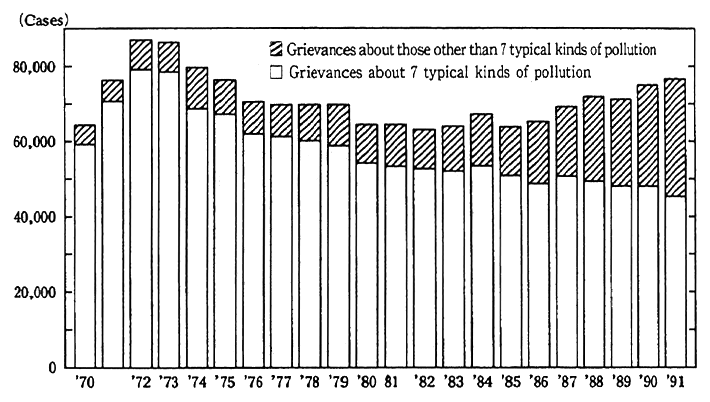
Source:Secretariat, Coordination Committee on Environmental pollution, Etc.: "Report on Findings of Survey on Number of Grievances about Environmental pollution in FY1991"
Grievances about environment pollution newly filed with local governments across the nation in fiscal 1991 totaled 76,713, and trends in this figure are shown in Fig. 10-1-2. Of the total, there were 46,650 grievances about seven typical kind of environmental pollution (Fig. 10-1-3). In the settlement of grievance about environmental pollution, as seen in Fig. 10-1-4 and 10-1-5, about three-fourths of the complainants were satisfied with the findings.
The filing and disposition of grievances with police about envi- ronmental pollution are indicated in Table 10-1-1 and 10-1-2.
Fig. 10-1-3 Kind-Specific Trends in Number and Component Ratio of Grievances (FY 1979-91)
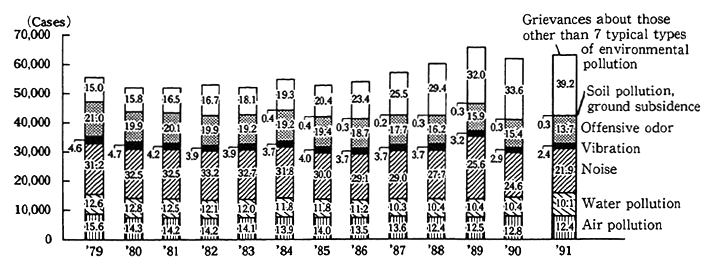
Notes:1. Secretariat, Coordination Committee on Environmental pollution, Etc.:"Report on Findings of Survey on Number of Grievances about Environmental Pollution in FY1991"
2. The values in the figure represent component ratios (%).
Fig. 10-1-4 Rate of Grievances about Environmental Pollution by Disposition Period

Fig. 10-1-5 Degrees of Complainants about Results of Disposition of Grievances about Environmental Pollution

Source: Secretariat, Coordination Committee on Environmental pollution, Etc. : "Disposition by Local Government Governments about Environmental Pollution in FY1990"
Table 10-1-1 Polution Complaints Filed with Police (1992)
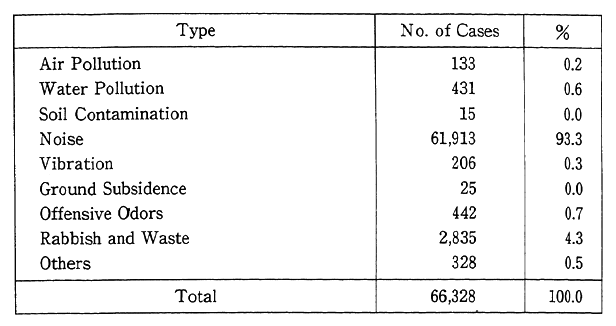
Source: National Police Agency.
Table 10-1-2 Police Response to Pollution Grievances (1992) Source: National Police Agency.
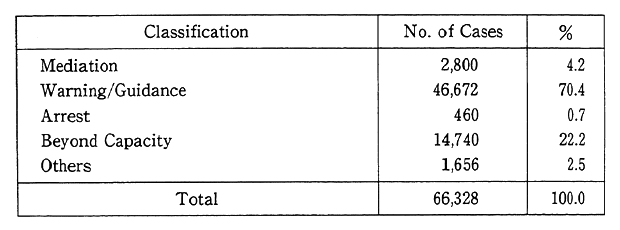
10-2 Controls on Environmental Pollution Offenses
10-2-1 Control Priorities and Arrests
In police controls, priority is given to the offenses which involve malicious and illegal disposal of industrial wastes and water pollution. Arrests made in connection with environmental pollution offenses in the last five years are shown in Table 10-2-1. The number of arrests, as classified by law and ordinance, is given in Table 10-2-2. The patterns of industrial waste offenses, which account for most of them, the kinds of wastes which are illegally disposed, and the locations are outlined in Table 10-2-3 and Fig. 10-2-1.
Table 10-2-1 Trends in Number of Arrests in Pollution Offenses
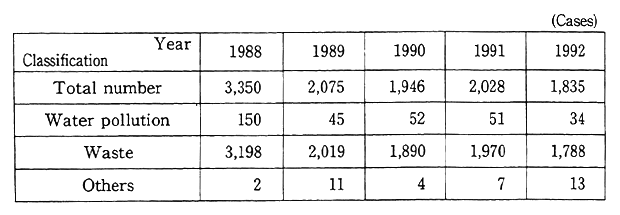
Remarks: Surveyed by the National Police Agency.
Table 10-2-2 Number of Arrests in Pollution Offense by Law (1992)

Remarks: Surveyed by the National Police Agency.
Table 10-2-3 Arrests by Type of Violation in Disposal of Wastes

Source: National Police Agency's survey.
Fig. 10-2-1 Illegal Disposition of Industrial Wastes by Kind and by Place
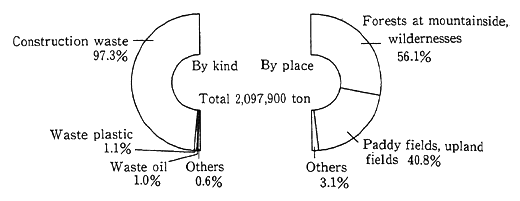
Remarks: Surveyed by the National Police Agency.
10-2-2 Acceptance and Disposition by Prosecutors Offices of Cases in Violation of Environmental Pollution-Related Laws and Ordinances
The acceptance and disposition by prosecutors offices of cases in violation of environmental pollution-related laws and ordinances are shown below (Table 10-2-4, Table 10-2-5 and Table 10-2-6).
Table 10-2-4 Trends in Ordinary Disposition of Violations of Environmental Pollution-Related Laws and ordinances and in Number of Persons Processed
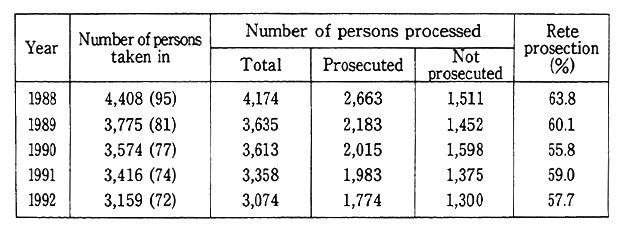
Notes:1. Surveyed by the National Police Agency
2. The figures in brackets represent indices with 1988 at 100.
3. Rate of prosecution=number of persons
Table 10-2-5 Offense-Specific Numbers of Persons Taken in on Charges of Violating Evironmental Pollution - Related Laws and Ordinances
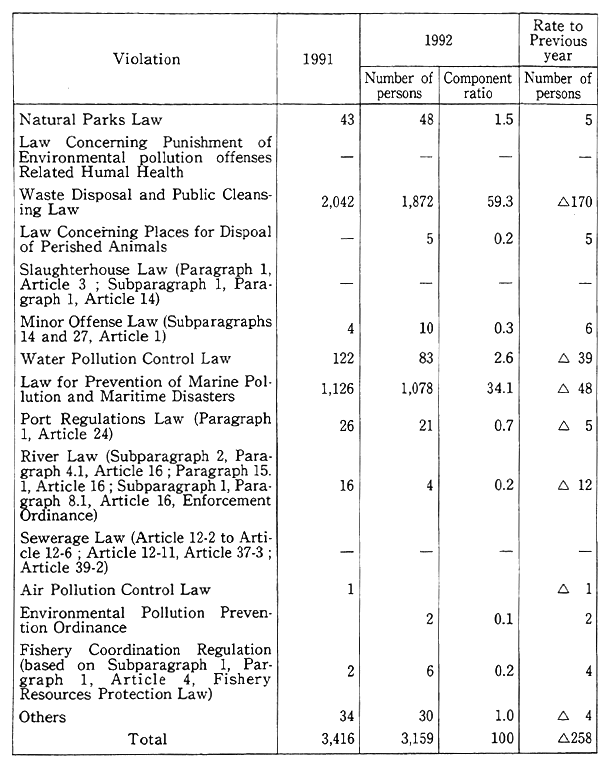
Notes:1. Source: Ministry of Justice
2. ![]() (in case of decrease)
(in case of decrease)
Table 10-2-6 Offense-Specific Number of Persons Processed in Violations of Environmental Pollution Laws and Ordinances
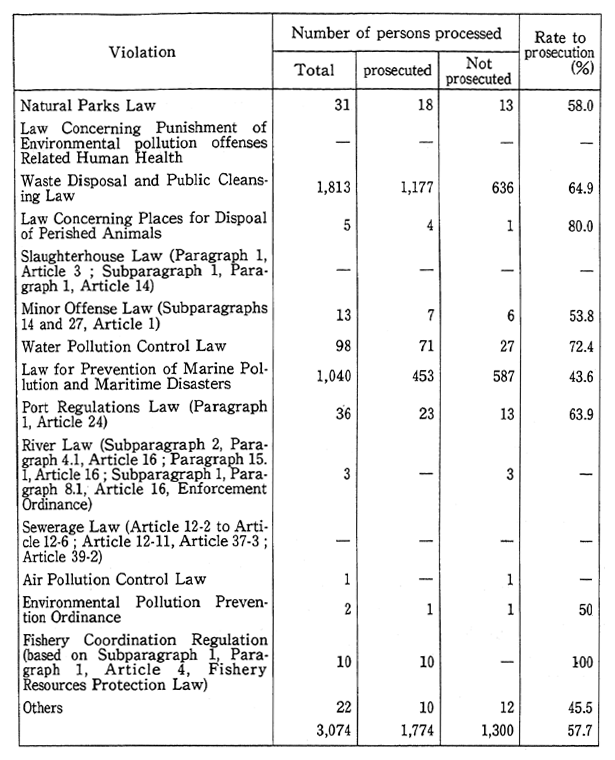
1. Surveyed by the Ministry of Justice
2. Rate of prosecution = number of persons prosecuted/(number of persons prosecuted + number of persons not prosecuted)
Chapter 11. Conservation of Natural Environment
11-1 Comprehensive Promotion of Measures for Conservation of Natural Environment
11-1-1 The National Survey on the Natural Environment
In order to accurately understand the present situation of the changing natural environment and foresee its direction, the National Survey on the Natural Environment is performed in accordance with Article 4 of the Nature Conservation Law. Generally known as the Green Census, this survey is conducted every five years to comprehen- sively and scientifically survey the conditions of Japan's natural envi- ronment. Following the first survey in fiscal 1973, the second in fiscal 1978 and 79, third one from fiscal 1983 to fiscal 1987, the fourth one has been under way since fiscal 1988. The survey is outlined in Fig. 11-1-1.
In fiscal 1992, the following surveys were carried out:
a. "Vegetation Survey" designed to detect the vegetation changes
b. "Animal Distribution Survey" designed to have a clear picture of the animal distribution
c. "River Survey" designed to understand the extent of artificial modification and the biota of rivers
d. "Marine Biotic Environment Survey" designed to understand the present state of tideflats, seaweed beds and coral reefs
e. "Coast Line Survey" designed to grasp the present state and its trend of degree of human disturbance of coast lines
f. "Comprehensive Ecosystem Monitoring Survey" designed to understand crucial aspects of ecosystems such as their characteristics and dynamics
Fig. 11-1-1 A Skelton of the 4 th National Survey on the Natural Environment
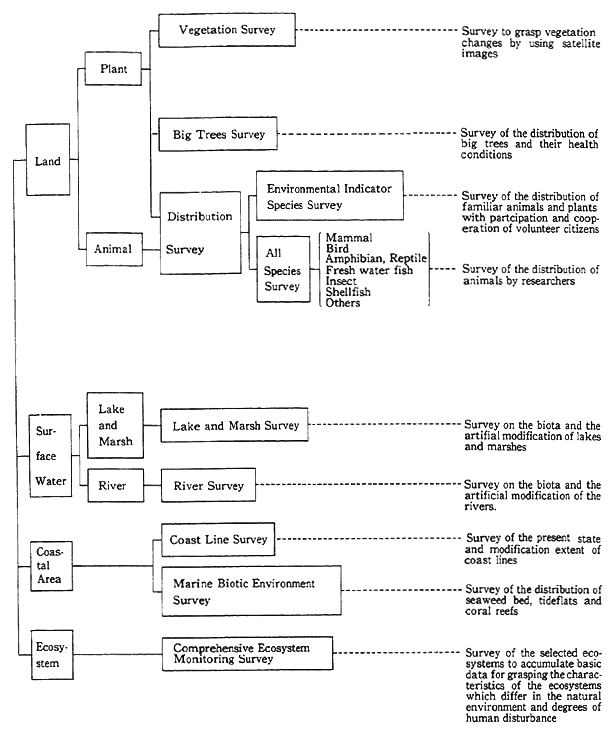
11-1-2 Increasing Awareness of Nature Conservation and Promoting of Nature Education
As increasing the desire for communing with nature among people, it has become more important to promote appropriate utiliza- tion of the natural environment.
In response to this demand, the Environment Agency carried out the following measures in fiscal 1992:
(1) Holding of various events for communication with nature
In order to enhance people's understanding, affection and ethical behavior towards nature, the Agency, utilized with Visitor Centers and Nature Trails, held the following events.
a. In commemoration of Green Day on April 29 (a national holiday), the "Green Day Gathering for Communication with Nature" was held in the Shinjuku-gyoen National Garden in Tokyo and in natural parks throughout the country.
b. During the Campaign for Communication with Nature which starts on July 21 and ends on August 20, nature observations and other various events are held in natural parks. The 34th Natural Park Festival, the central event of the campaign, was held in the Shikotsu- Kohan area of the Shikotsu-Toya National Park.
c. Aimed at enhancing public awareness and health through walking in nature, the National March ensloganed "Let's Walk Nature Trails" takes place along nature trails in 47 prefectures in October.
(2) Training Leaders for Promoting Communication with Nature
In order to prepare volunteers in national parks, the Agency carried out the Park Volunteers Project in the Setonaikai National Park and other two park.
In addition, the Agency held a training for interpretation staffs and orientation seminars for newly-committed volunteer park rangers.
11-1-3 Citizen Participation in Nature Protection
National Trust activities designed to acquire tracts of land whose natural environment is favorable, manage them and work for their conservation with the people's voluntary involvement through fund- raising and other activities are being promoted at many places across the nation, such as the Campaign for the Building of an Okhotsk Village in Koshimizu Town, Hokkaido, and the Citizens' Campaign for Conser- vation of Cape Tenjinzaki. Those activities are quite instrumental in promoting nature conservation activities from within the citizens, and their dissemination and settlement are desirable.
In fiscal 1992, non-profit organization for nature conservation (non-profit organizations whose primary purpose is to purchase and manage tracts of land whose natural environment is favorable) were designated as specified judicial persons for public good promotion, for whom preferential tax measures are available, including credit for contribution loss they have received. A symposium was held at the Tenth National Convention of the National Trust for a further dissemi- nation of information on its activities.
11-2 Conservation of Natural Parks
11-2-1 Conservation of Nature Conservation Areas.
In accordance with the provisions of the Nature Conservation Law, it is stipulated that wilderness areas (the areas whose natural environment is maintained in a primeval state without being affected by man's activities) and nature conservation areas (the areas where conser- vation of the natural environment is especially important for natural and social conditions other than the wilderness areas). As of the end of fiscal 1992, five areas were designated as wilderness areas and Ten areas as nature conservation areas.
It is also stipulated that prefectures may designate as prefectural nature conservation areas those areas where conservation of the natural environment is especially important in accordance with decrees, etc. As of fiscal 1992 514 areas had been so designated. (Table 11-2-1)
Table 11-2-1 Classified Areas in Natural Conservation Areas etc.
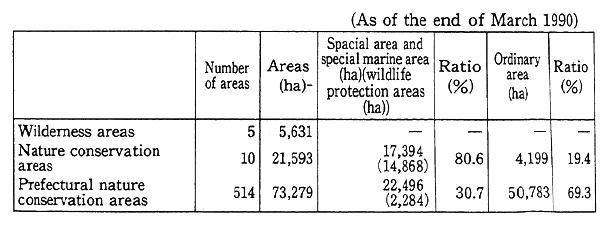
Remarks: Surveyed by the Environment Agency.
11-2-2 Protection of Nature in Nature Conservation Areas.
In light of the importance of nature conservation areas, studies are conducted to contribute to their reasonable conservation. By fiscal 1989, fact-finding studies have been conducted in all wilderress areas. In fiscal 1991, specialist studies were made on the formulation of future research and study programs. In fiscal 1992, in accordance with the studies in fiscal 1991. the second studies were conducted in 3 wilderness areas. A fact-firding study was also conducted in Shiragami-sanchi nature conservation area which was newly disignated in 1992.
11-2-3 Designation of Natural Parks and Review of Park Schemes
(1) Designation of National and Quasi-National Parks
The natural parks fall under the following three categories:
A. Prominent natural scenic areas which represent Japan's scenic wonders are designated as national parks.
B. Surpassing natural scenic areas which are almost as beautiful as national parks are designated as quasi-national parks
C. Scenic areas which represent the scenic splendors of prefectures are designated as prefectural natural parks.
Up to now, many natural parks have been designated, thus contributing to the conservation of the natural environment and playing an important role as places for communion with nature, such as the experiencing of wilderness, nature observation and outdoor recreation.
The status of designation of natural parks as of the end of fiscal 1992 is indicated in Fig. 11-2-1 and Table 11-2-2. They consist of 28 national parks (2,050,000 hectares), 55 quasi-national parks (1,330,000 hectares) and 301 prefectural natural parks (1,950,000 hectares). Their total area measures 5,330,000 hectares, accounting for 14% of the national land.
Fig. 11-2-1 Location of National and Quasi-National Parks
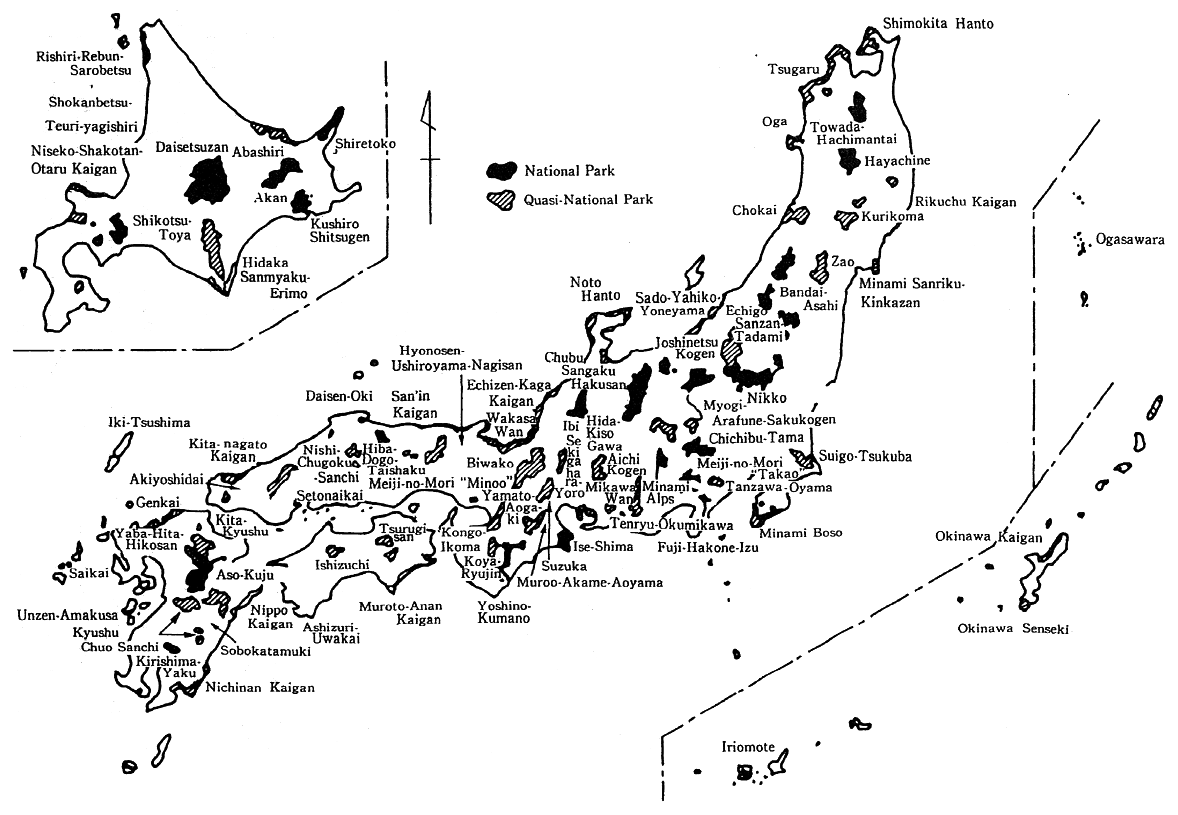
(2) Designation of Marine Park Areas
The Director General of the Environment Agency designates marine park areas in the national and quasi-national parks and takes necessary regulatory measures, thus working for their reasonable utili- zation.
As of the end of fiscal 1992, a total of 58 areas measuring 2,439 hectares, which included 28 areas in national parks and 30 areas in quasi-national parks, were designated as marine park areas.
(3) Review of Park Schemes
Park schemes are formulated to work for the reasonable protec- tion and utilization of natural parks, but in order to respond to social and other conditions that involve national parks, park schemes have been under review since fiscal 1973 with primary attention focused on the increased protection of nature. For parks where review has been completed, it is a practice to check their park schemes every five years in general. In fiscal 1992, review were completed on the Akan National Park, Chubu-Sangaku National Park etc.
Park schemes at quasi-national parks are also under review by the State and prefectures in nearly the same manner as national parks. In fiscal 1992, park scheme was reviewed for the Biwako Quasi- National Park etc.
Prefectural natural parks do not have formulated park programs, thus guidance was provided so that park programs could be formulated.
(4) Designation of Areas with Controls on Admittance
In conjunction with a revision of the Natural Parks Law in 1990, it was decided to take regulatory measures on the use of horses and vehicles or powerboats or on the take off and landing of aircraft.
The idea is to prevent adverse effects on the habitat and growth of wild fauna and flora due to the rapidly increasing use of snowmobiles, off-the-road vehicles and so forth in recent years. By the end of fiscal 1992, 26 areas measuring 136,680 hectares in 18 parks, including the Fuji-Hakone-Izu National Park, had been designated as areas where admission restriction would be enforced.
11-2-4 Protection of Nature in Natural Parks
(1) Protection of Scenic Beauties in Natural Parks
a. Controls on Activities in Natural Parks
In order to protect scenic beauties in the natural parks, special areas, special protection areas and marine park areas are designated (Table 11-2-2). For various activities in those areas, it is necessary to get permission from the Director General of the Environment Agency or the governor of the prefecture. Efforts are made for the reasonable protec- tion of scenic beauty, such as with the application of the Guideline to Assess on Various Development Activities in National Park Areas (excluding ordinary areas). The number of applications for permission, filed with the Director General of the Environment Agency, in the special areas and Special protection areas of national parks is given in Table 11-2-3. Even in ordinary areas, reports must be filed with the governor of the prefecture when it comes to certain activities. As regards the development of golf courses in ordinary areas, a guideline is formulated and efforts are made for the reasonable protection of the scenery.
Table 11-2-2 Classified Areas in Natural Parks

Remarks: Surveyed by the Environment Agency. The national land area 37,775,028 hectares (as of October 1991 by National Land Institute.)
Table 11-2-3 Application for Permission of Activities in National Parks (Permission by the Director General of the Environment Agency)

Notes: 1. Surveyed by the Environment Agency.
2. "Others" changes in land configuration etc.
3. Figures in parenthese are in the special protection areas.
4. Number include deliberation by organization of national government.
b. Studies and Surveys on Methods for Management of Scenic Beauty
In order to protect and manage the core of each natural parks where one finds invaluable nature, the core of each natural park, studies are conducted for the understanding of factors which will bring about changes in the inherent ecosystems of the areas, striving to establish protection and management methods. In fiscal 1992, studies on measures for conservation of the sand dunes of Tottori in the San'in-Kaigan National Park were conducted.
(2) Environmental Conservation Measures at Natural Parks
The following measures are taken for environmental conserva- tion at natural parks:
a. Beautification and Cleaning Projects
* Nurturing and strengthening of groups for beautification and cleaning at high attendance national parks.
* During the first Sunday of August designated as the Natural Park Cleaning Day, the cleaning of natural parks is simultaneously done across the nation.
b. Projects for Conservation of Special Plants, Etc.
* Some all precious plants which grow in the national parks, are protected along with their growth environment. In order to imple- ment measures for their protection and propagation, the costs required by related local governments for surveys on the restora- tion of vegetation, the environment and so forth were subsidized for the Oze Marsh (Nikko National Park) and other places
c. Projects for Extermination of Acanthaster plancietc.
* In order to protect the scenic beauty of the marine park areas in the national and quasi-national parks where Acanthaster planci and Drupella cornus were spreading, extermination costs required by local governments were subsidized.
d. Measures to Improve Utilization of Automobiles
* In accordance with the Outline on the Rationalization of the Utilization of Automobiles in National Parks (by the Environ- ment Agency in March 1974), measures are taken, such as traffic controls under the Road Traffic Law and the operation of buses in place of private cars and so forth.
e. Measures for Conservation of Specified Natural Environment Areas
* In order to reasonably protect the ecosystems of national parks, experiments and surveys were performed for conservation of the spruce forests in the Odaigahara area of the Yoshino-Kumano National Park and the Sarobetsu wilderness of the Rishiri-Rebun- Sarobetsu National Park.
* Projects for emphatic management of specified national parks were carried out in the Shiretoko National Park to obtain cooper- ation from the district forest office.
f. Measures for Conservation of Lakes and Reservoirs
* In order to conserve the water quality of lakes, reservoirs and rivers in natural parks, attempts were made to promote sewerage development and other projects, in particular specified public sewage systems for environmental conservation.
(3) Strengthening of Management Systems
As regards the management of national parks, a national park office is established in each national park, and efforts are made to manage them in a reasonable manner with the cooperation of local governments and private organizations. In recent years, efforts have been made to strengthen the management of national parks in order to cope with changes in the various conditions which involve national parks.
a. National Park Offices, Etc.
In order to protect and control the scenic beauties of national parks and carry out a broad range of activities, such as guidance to park custodians and information on nature to park users, national park offices are established in 11 national parks. As of the end of fiscal 1992, there were 128 national park rangers.
In order to carry out management in an appropriate manner in conformity with the actual conditions of each national park, a manage- ment plan is formulated. As of the end of fiscal 1992, management plans were formulated for 7 areas of 6 national parks (for example Shiretoko.
b. Private Organization Activities
a) The Natural Park Beautification and Management Foundation, carried out park beautification and clean up, the maintenance and management of park facilities and the enhancement and promotion of consideration to nature protection and other projects in the 18 areas, including the Kamikochi area of the Chubu Sangaku National Park and Hyonosen area of Hyonosen-Ushiroyama-Nagisan Quasi-National Park.
b) The Honshu-Shikoku Linkage Bridge Fund for Natural Conser- vation, a foundation, performed beautification and clean up projects and projects for the promotion of consideration of nature protection as measures for conservation of the peripheral natural environment of the Honshu-Shikoku Linkage Bridge (Kojima-Sakaide route).
c) Volunteer Fund for Nature Conservation supported 17 numbers of volunteer organizations which performed beautification in the Natu. ral Parks, restoration of vegetation and nature interpretation.
(4) Promotion of Private Land Purchases for Nature Protection
In order to balance the maintenance of scenic beauties in national and quasi-national parks and the protection of wild animals and birds in National wildlife protection areas, with the rights of private land owners in those areas, and on the other, prefectural governments have been financially assisted in their purchases of private land.
The actual records in the last five years are shown in Table 11-2-4. Up to now, 57 plots covering a total area of 6,360 hectares (with a total project outlay of ¥11,24O million) have been purchased.
Table 11-2-4 Purchase of Privately Owned Land with Subsidies for Redemptions on Local Grant Bonds
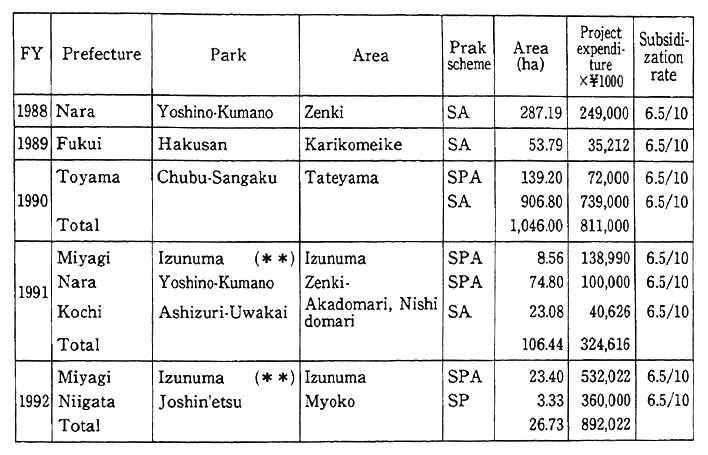
Note:SA : Special Area, SPA: Special Protection Area
Remarks:1. Surveyed by the Environment Agency.
2. (*) : quasi-national park, (* *) : wildlife protection area, otherwise, the listed are national parks.
11-3 Conservation of Forests
The following measures are implemented to conserve forests:
(1) Forest Programs
In order to address the multiphasic functions of forests, such as lumber production, conservation of the land and water sources, and formation and conservation of the natural environment in a comprehen- sive and sophisticated manner, the forest planning system has been appropriately enforced and appropriate forest projects have been promoted.
(2) Forest Land Development Licensing System
In order to assure reasonable utilization of forest land through the operation of a forest land development licensing system the guid- ance and subsidization for prefectures' operating rules were made.
(3) Protected Forests System
In order to address the public-good functions of forests, including conservation of land and, the water sources, formation and conservation of the natural environment and offer of places for relaxation and rest, "protection forests" were systematically designated and "special protec- tion forests" were designated for forests with reduced function, both according to a protection forest development program to appropriately maintain and control protection forests.
(4) Conservation and Management of Forests
The following measures were taken for conservation and man- agement of forests:
(A) Forest Pest Control Measures
Measures for the extermination of forest blight and measures to cope with damage done by pine weevils were implemented in accor- dance with the Forest Blight Extermination Law, the Special Measures Law on Measures to Cope With Damage Done by Pine Weevils,
(B) Measures Against Forest Fires
Patrols for the conservation of forests, the installation of mate- rials and equipment for the prevention of forests fires, and the develop- ment of roads in fire prevention zones were subsidized.
(C) Public Participation
In order to promote the development of forests with public participation and accordance with public intentions, the development of a Fund for Forests with Green and Water was promoted, Additionally, the proceeds-sharing forest system was promoted.
(D) Areas are designated for the protection of primeval ecosystems to conserve primeval natural forests in State owned forests. This will contribute to maintenance of the natural environment made up of primeval ecosystems. As of April 1992, 15 places with a total area of about 188,000 hectares were designated, including Kariba Mountains, the Shirakami Mountains and Yakushima, were designated.
(E) In order to conserve rare species of wild fauna and flora such as Japanese Crane, Tsushima Cat and Rebun Lady's Slipper, Spe- cific Animal's Habitat Reserves and Plant Community Reserves were established to preserve occurences and habitats of those wild species.
Also, patrols in all reserves were performed for promoting con- servation of wild animals and plants.
11-4 Protection of Wildlife
11-4-1 Promotion of Endangered Species Protection
(1) Establishment of the Law for the Conservation of Endangered Species of Wild Fauna and Flora
As a result of the Environment Agency's Study on threatened Fauna and Flora in Japan, it was found that many species were in danger of extinction. It has internationally become an urgent task to protect extinction of the endangered species.
In order to promote of systematically conservation of Interal and extarnal endangered species of wild Faunaand Flora, the Environment Agency promoted examiration of a new legal system, and on May, 1992, the Law for the conservation of Endangeral Species of wild Fauna and Flora (LCES) was passed the 123th Diet, and on June 5, it was promul- gated.
In LCES, endangered species whose natural geographic distribu- tion is known in Japan, are designated National Endangered Species, and regulated taking, transfer and international trade by the govern- ment. For the purposes of ensuring the conservation of National Endan- gered Species are designated as Natural Habitat Conservation Areas, any action prohibite in this area. The rehabilitation of natural habitats and the maintenance of viable populations of National Endangered Species promote.
On the other hand, species that are listed in CITES (Convention on International Trade in Endangered Species of Wild Fauna Flora) or in Japan's bilateral conventions or agreements on protecting Migratory Birols are designated International Endangered Species, regulated tran- sfor and international trade.
In advance of LCES will enforce on April 1,1993, on November, 1992, the Basic Policy, for the Conservation of Endangered Species of wild Fauna and Flora that showed basic point of view for selecting the National Endangered Species. On February 1993, as preparation for enforcement of LCES, the National or International Endangered Species were designated from species that were regulated by Law for the Regulation of the Transfer of Designated Special Birds or Law for the Regulation of the Transfer of Endangered Species of Wild Fauna and Flora. These law will repcal when LCES enfore.
(2) Protection of Endangered Species
The following studies and projects are carried out as measures to protect fauna and flora in danger of extinction:
a. Monitoring surveys were conducted on habitation of about 80 species listed in the Red Data Book prepared by the Environment Agency, in the cooperation with local specialists and scientific societies.
b. Surveys were conducted on the habitation of Crested serpent eagles, Pryer's woodpeckers, Japanese cranes and etcetera designated as special birds.
c. The artifical propagation project for Japanese crested ibis between Japan and China has started at March 1990. In this project, the Japanese gorn male indivisual "Midori" and the Chinese indivizual "Yaho-Yaho" were crossbreeding at Beijing Zoo. In April 1992, "Yaho- Yaho" laied two eggs, but the eggs were unfertilized. So, the Environ- ment Agency brought back the male indivizual to Japan. The Agency has constructed a Sado Ibis Breeding Center for breeding project and diffusion and enlightenment. d. The feeding and monitoring of Iriomote wild cats and Tsushima wild cats in the wintertime were conducted.
e. The Environment Agency started the Study on the Technique for Dispersion of Short-tailed Albatross's Breeding Colony.
f. The feeding and monitoring of Japanese cranes in wintertime were conducted. 611 Japanese cranes were confirmedi in January 1993.
g. Blakiston's fish owls were provided with nest boxes and feed. The Environment Agency started the Project of Introduction to New Hab- itat for-Formation of Pairs.
h. Surveillance was done of Japanese macaques in the Shimokita Peninsula and the conservation of their habitat environment and other protection measures were taken.
i. Projects for artificial propagation were conducted for freshwater pearl mussels and Euryale ferox, a plant.
11-4-2 Measures for Protection and Control of Wildlife
(1) Promotion of Wildlife Protection Project
National wildlife prooection areas were newly established at Tofutsu-ko and were designated as special protection areas. Besides, establishment of prefectural wildlife protection area, caputure of har- muful wildlife for repellant purpose, protection of sick and wounded wildlife etc. were promoted as wildlife protection project according to the seventh wildlife protection project program (Table 11-4-1).
Table 11-4-1 Present State of Wildlife Protection Area

(2) Promotion of Measures for Protection of Migratory Birds
The project of wild-rice planting was conducted in order to conserve habitat of waterbirds such as whistling swan, etc., at Izunuma lake in Miyagi Prefecture where has been designated as National Wildlife Protection Area and the Ramsar site.
And, towards the fifth meeting of the Conference of the Contract- ing Parties to the Ramsar Convention which will be held at Kushiro of Hokkaido in June, 1993, the Asian Wetland Symposium was held in cooperation with related local governments and non-government orga- nizations at Otsu in Shiga Prefecuture and Kushiro in October, 1992. In this symposium, about 150 persons such as experts, administrators, members of non-government organizations participated from Asian countries and the interior, and took place an exchange of opinions concerning wetland conservation and protection of waterbird.
Important points where many migratory birds visit were designated as Class I (10 locations) and Class II(50 locations) observa- tion stations and bird-banding surveys were conducted. In order to develop the basic data on the wintering of wild geese, wild ducks and the visiting of sandpipers and plovers, surveys on habitation of those wild birds and fixed observation were conducted.
(3) Measures for Protection of Wildlife and Prevention of Damage
For the purpose of establishing a policy to realize coexistence between wildlife protection and human life, the Government launched "Wildlife Management Manual Project" in FY 1992. The subject in the first year was Deer.
Japanese Macaques and Asian black bears were surveyed in order to establish methods for the control of population and preventive technology. Crows, Domestic pigeons and deer were surveyed to work out measures against their damages to agriculture and forestry.
Measures are taken for the protection of Japanese serows and the prevention of their damages. As part of the measures, the numbers of population are controlled in areas where their damages are serious (the prefectures of Gifu, Nagano, Aichi and Yamagata).
11-4-3 Control of Hunting
(1) Present Situation of Hunting
At present, wild ducks, pheasants and 28 other birds and wild boars, male deer and 15 other animals are designated as game species. The number of hunting licenses issued and that of wildlife hunted are indicated in a separate table (Table 11-4-2).
(2) Assurance of Safety Hunting
Guidance was given to prefectures and hunting-related organiza- tions to prevent accidents in hunting and illegal activities and assure safety hunting.
Table 11-4-2 Number of Hunting Licenses Lssued and Wildlife Hunted
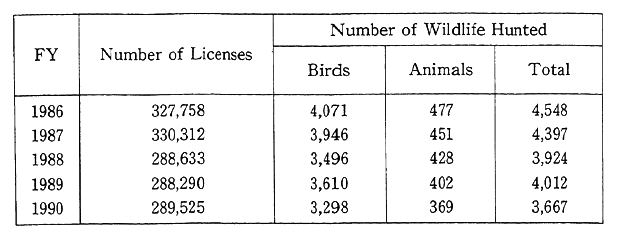
(3) Establishment of Hunting Areas
The "hunting areas" are a system which is designed to pave the way for an orderly and controlled hunting by demarcating areas where hunting may be done and the number of hunters, the duration of hunting, the types of game species and their number are restricted, while attempts are made to work for the positive protection and propagation of game species, such as with the release of wildlife. Establishment of hunting areas are shown in Table 11-4-3.
Table 11-4-3 Establishment of Hunting Area
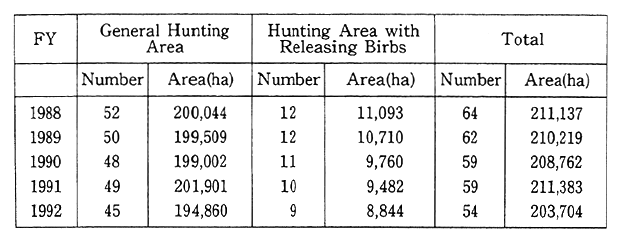
(4) Prohibition from Hunting Bears with Kukuriwana (Tied Trap)
Hunting bears (Black bear and brown bear) with Kukuriwana (Tied trap) has a problem about suitable wildlife management because of its high hunting efficiency. It is also pointed out its dangerousness and cruelty. Therefore the Government prohibited from using the trap to hunt bears from the 1st October 1992.
11-4-4 Propagation and Enhancement of Understandings About Protection of Wildlife
In order to promote the propagation and enhancement of under- standings about protection of wildlife, the 46th Wild Birds protection week "National Rallyfor the protection of Wild Birds" in Kanagawa Prefecture was held, and the Meeting for the Presentation on the Protection Activities of Wildlife, those such as at the Model School conserving wild bird, was held.
11-4-5 Promotion of Conservation and Management of Fishery Resources
In order to promote the conservation and management of fishery resources, other than the following measures, regulations such as restriction of capturing under the Fisheries Law and the Fisheries Resources Protection Law were performed.
a. In order to promote effective conservation and breeding opera- tion of rare fresh water fishes which inhabit Japan, Assual Meeting on Propagation of Rare Fresh Water Fisheries in Japan which consists of national fisheries research institutes and prefectural fisheries experi- mental stations, was set up to gathre and exchange information of living status and breeding techniques of those fishes.
b. For the conservation of sea turtles, prefectural regulation of fishery adjustment and instruction of Fishery Adjustment Commission based on the Fisheries Law and the Fisheries Resources Protection Lawwere performed to regulate capturing appropriately. Also, conser- vation projects to protect nesting sites and habitat of sea turtles con- ducted by local governments, including removal of wastes such as piled vinyl bags and prevention of poaching eggs and hutchlings of sea turtles, were subsidized by the central government.
11-5 Provision of Facilities for Communing with Nature
11-5-1 Provision of Natural Park Facilities
The number of persons who used natural parks in 1991 reached about 1,014 million. Up 1.7% from that of the previous year. This means that the people's desire to commune with nature is gathering.
And in order to realize our enjoyable and comfortable daily lives, the provision of the following core facilities in conformity with the quality of nature is promoted. The system is indicated in Fig. 11-5-1.
Fig. 11-5-1 System for Provision of Natural Parks
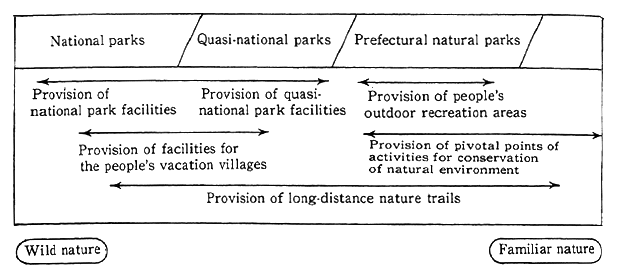
(1) Facilities in National and Quasi-National Parks
National and quasi-national parks feature the excellent natural environment, picnic site, nature trail, camping sites, public toilets and other facilities provided in order to promote their safe and comfortable utilization in response to people's calls for communion with nature. Particularly as regards public toilets, emergency renewal projects begun in fiscal 1991 are still in effect. Provision of facilities in national and quasi-national parks in fiscal 1992 is outlined in Table 11-5-1.
Table 11-5-1 Provision of National and Quasi-national Parks in FY1992
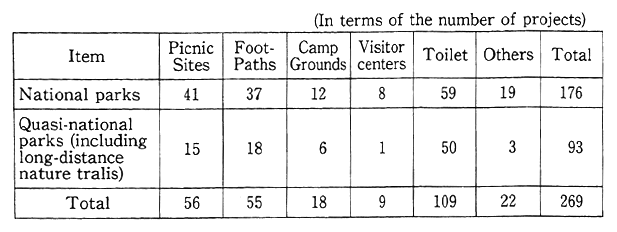
Remarks: Surveyed by the Environment Agency.
(2) People's Vacation Village
People's Vacation Villages are established at the places suitable for recreation within National Parks or Quasi-National Parks where natural environment is excellent. In the Villages, lodging facilities, which are healthy, neat and not expensive, as well as other facilities for outdoor activities are provided and well organized synthetically. 32 Villages were already established and well managed.
Non profit public facilities such as picnic sites, trails, camping sites, etc. among the facilities of People's Vacation Villages, are arran- ged by the Environment Agency or local public bodies concerned. On the other hand, profitable facilities such as hotels, lodges, skiers' lifts, etc., are ranged and managed by the People's Vacation Village Association. Trends in the number of people's vacation village users are shown in Table 11-5-2.
Table 11-5-2 Trends in Number of Users of the People's Vacation Villages
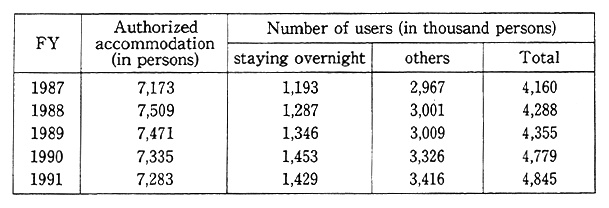
Remarks: Surveyed by the Environment Agency.
(3) People's Outdoor Recreation Areas
The people's outdoor recreation areas are those which are pro- vided with priority given to enabling suburban visitors to come in deeper communion with nature through their activities to positively work on nature and to get themselves acquainted with harmony between nature and man. Facilities for display of exhibits (community natural parks and centers), picnic site, camping grounds, trail and other facilities are to be provided in five years. In fiscal 1992, construction in six areas was continued and in one area it was begun.
11-5-2 Provision of Facilities for Recreation and Communion with Nature
(1) People's Lodges
The people's lodges are facilities which are designed to enable people to have healthy, neat and not expensive lodging at nature spots and fit for rest. As of the end of fiscal 1991, the number of people's lodges in busiuess was 284 and that of users was 8,660,000 (Table 11-5-3).
Table 11-5-3 Trends in Number of People Using People's Lodges
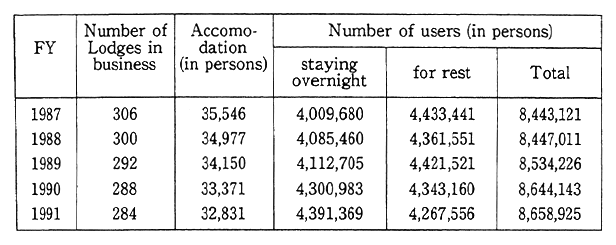
Remarks: Surveyed by the Environment Agency.
(2) People's Recreation Centers
The people's recreation centers are facilities which are designed primarily to enable community residents to engage in day recreation activities and rest for health care at places suitable for rest. As of the end of fiscal 1991, the number of centers was 67 and that of users was 3,070,000 (Table 11-5-4).
Table 11-5-4 Number of Peoplis Recreation Centers and Users

Remarks: Surveyed by the Environment Agency.
(3)Pivotal Points of Activities for Conservation of Natural Environment--"Communities for Communication with Nature and Native Living Things" and "Communities with Natural Surroundings and Culture"
In the areas where nearby natural features, such as dragonflies, fireflies and other small animals, green in the fields, surroundings around streams and lakes etc. still remain, "The Communities with Natural Surroundings and Culture" and "The Communities for Commu- nication with Nature and Native Living Things" are provided as pivotal points to maintain nature and to promote nature education.
Nature center as pivotal points of activities, observation facil- ities, ecosystem conservation facilities and so on are provided. Interpre- tation on nature is provided with the cooperation of volunteers. In fiscal 1992, three of the "communities with natural surroundings and culture" and three of the "communities for communication with nature and native living things" were provided (Table 11-5-5).
Table 11-5-5 Pivotal Points of Activities for Conservation of Natural Environment
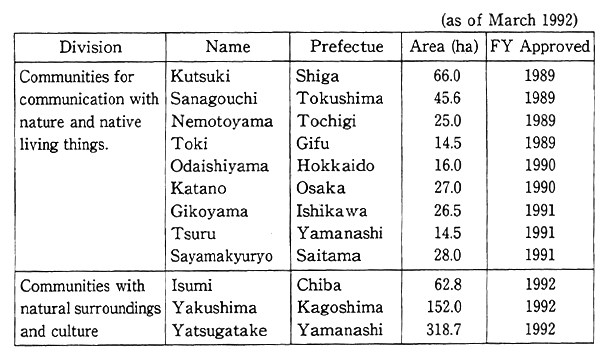
Remarks: Surveyed by the Environment Agency.
(4) Long-Distance Nature Trail
The system of long-distance nature trail is designed to enable people to physically and mentally develop themselves in a sound manner and deepen their understanding about nature by coming in contact with nature and visiting historic remains by themselves. The development of long-distance nature trail was started in fiscal 1970 to organically link natural parks and cultural assets. This system is designed to enable people to utilize it at all seasons, safely and comfortably. Their aggre- gate length is approximately 14,000 kilometers. In 1992, Tokai, Kyushu and Chugoku Nature Trail were renewed to raize their usability. The number of users in fiscal 1991 was 32,420,000 (Table 11-5-6).
Table 11-5-6 Outline of Long-Distance Nature Trails
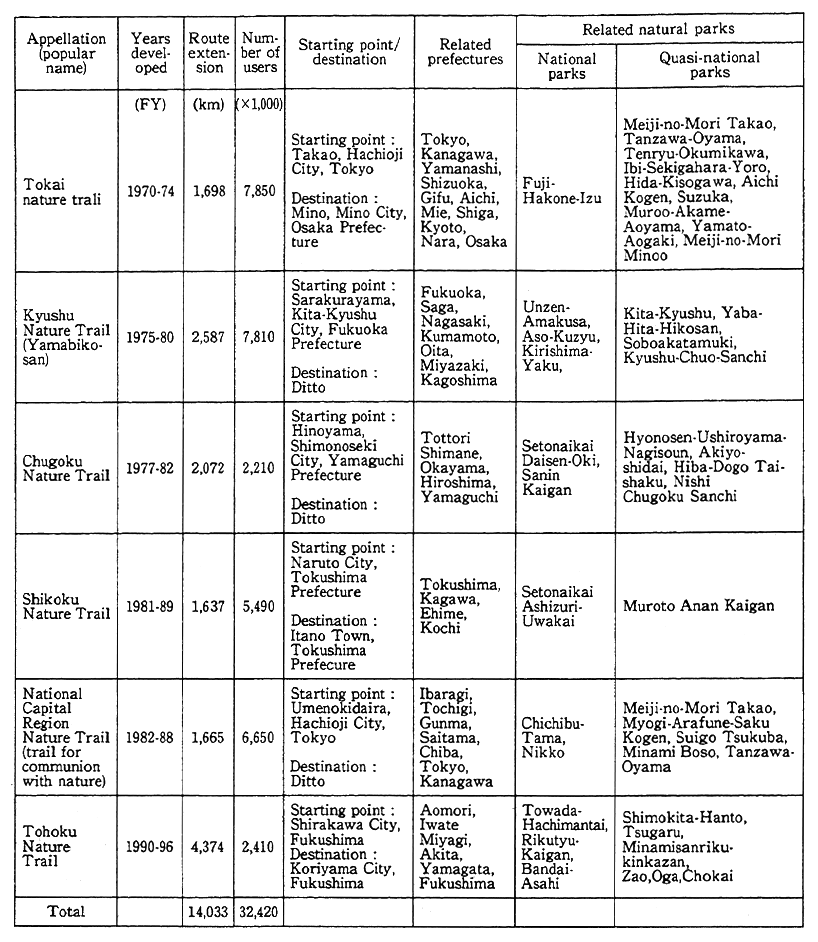
Remarks: Only part of the Tohoku Nature Trail is open.
(5) Protected Forests for Health, Protected Forests for Rest, Etc.
Forests with significant functions for conservation of the environ- ment and for health and rest were designated as "protected forests for health." The "protected forests for health" and the "scenic protected forests" measure about 590,000 hectares.
Of all State-owned forests, forests for rest in nature and other recreation forests (about 550 ,000 hectares) were developed, maintained and managed for health and rest. Also were developed the Human Green Plan under which a wide variety of forest recreation facilities would be comprehensively developed in State-owned forests.
(6) Family Camping Villages
The Family Camping Villages are basic facilities for tourism centering around autocamping facilities which residents in the nearby communities can easily use at reasonable rates in response to the strengthened orientation of the people toward nature and a rise in demand for sightseeing and recreation. Located in natural environment, these villages are maintained with full consideration given to the conser- vation of the environment. With these facilities, places are secured where people are brought into contact with splendid nature. They also contribute toward development of the communities where they are situated.
In fiscal 1992, construction of these villages was started in Kita-Ibaraki City, Ibaraki Prefecture; Suzu City, Ishikawa Prefecture; Taisho Town, Kochi Prefecture, and Kawabe Town, Kagoshima Prefec- ture.
(7) Villages for Family Vacation
The system of villages for family vacation is designed to secure sightseeing and recreation places in nature which may readily be used primarily by families, thus contributing to local development. In fiscal 1992, the development of 12 areas were carried on.
(8) Homes for Young People in Nature
Homes for young people in nature are facilities for social educa- tion with a view to encouraging them to familiarize themselves with nature and work for their sound growth. 14 national homes for young people in nature across the nation had been completed by fiscal 1991. In fiscal 1992, construction of 2 public home for young people were subsid- ized.
11-5-3 Protection and Utilization of Hot Springs
(1) Protection and Utilization of Hot Springs
Japan is a country prominent with hot springs in the world, and the places where hot springs are available play an exceedingly impor- tant role as places of health and rest for people. As of the end of fiscal 1991, there were 23,097 hot springs (including 5,091 self-gushing hot springs and 10,639 pump-up hot springs), and about 3,300,000 tons of hot spring water gushes each day.
For protection and utilization of those hot springs, the Hot Spring Law contains the following regulatory measures:
Digging, additional digging and pump-up systems of hot springs The permission of prefectural governors is requested
The offer of hot springs for bathing or drinking The permission of prefectural governors or mayors of specified cities is required.
The number of permits granted across the nation in 1991 was 1, 100 for digging, 82 for additional digging, 626 for pump-up systems and 2,409 for bathing or drinking.
(2) Hot Spring Health Resort
The places in which full effects may be expected from the utilization of hot springs and which may be fully used as sound places for rest are designated by the Director-General of the Environment Agency as "hot spring health resort" under the Hot Spring Law. As of the end of January 1993, 80 places with a total area of 12,042.06 hectares were designated.
In fiscal 1991, seven places were newly designated as hot spring health resort. Also fiscal 1992, the provision of facilities for athletic facilities and those for picnic site etc. was subsidized.
11-6 Conservation and Development of the Natural Environment, in Urban Areas
11-6-1 Conservation of Natural Environment in Urban Areas
The natural environment in urban areas played a significant role, such as in air purification and the easing of climate conditions, and is indispensable for creation of a comfortable urban environment, includ- ing supply of space for recreation. The following measures were taken for conservation of the natural environment in such urban areas.
(1) Development of National Garden and Chidorigafuchi National Cemetery to the War Dead
The Outer Garden of the Imperial Palace, which was a former garden for the Imperial Family, the Shinjuku Imperial Garden and the Kyoto Imperial Garden have been under the custody of the Environment Agency as the National Garden since 1971 and used by people, and the parks are well liked.
The Outer Imperial Garden covers an area of 114.9 hectares. The Kita-no-Maru section of this garden is developed as a forest park primarily with Japanese black pine trees and grass. The Shinjuku Imperial Garden is a garden blending Japanese and Western styles typical in the Meiji era with an area of 58.3 hectares. In addition to 1, 900 cherry blossom trees in about 50 species, flowering trees are so arranged that people may enjoy flowers throughout the year. The garden is visited by 860,000 people a year. The Kyoto Imperial Garden, surrounding the Kyoto Imperial Palace, is rectangular with an area of 65.3 hectares, measuring 1,300 meters north to south and 700 meters east to west. Both at the imperial gardens of Shinjuku and Kyoto, a "forest for mothers and children" is developed for the observation of nature.
The Chidorigafuchi National Cemetery for the War Dead is a garden with an area of some 1.6 hectares, enshrining the ashes of 334,494 servicemen (as of March 1993) whose surviving families are unknown.
In order to contribute to the pleasant use of the gardens, the toilets were improved and the garden paths repaired in fiscal 1992. In addition, maintenance and control measures were taken, including the cleaning of the garden and trimming of the laws and trees, and equip- ments cleaning up the water in the moat of the outer garden are set.
(2) Development of City Parks
As regards city parks, five-year plans for the development of city parks have been formulated to promote their development under the Law Concerning Emergency Measures for the Improvement of City Parks. A check of development of city parks indicates that the area of city parks, etc., per person of the subject population came only to 5.8 m2 (as of the end of fiscal 1989).
In fiscal 1992, the second fiscal year for the Fifth Five Year Plan for the Development of City Parks, Etc. (with a total outlay of ¥5 trillion, including ¥2,230 billion in general public works projects, and with the development target of about 7.0 m2 person by the end of fiscal 1995), attempts were made for the positive development of city parks, etc., with an outlay of ¥127,290 million (including ¥317.1 billion in general public works outlays).
(3) Conservation of Urban Green Space
Under the City Green Space Conservation Law, areas for the conservation of green space are designated. In those areas, a licensing system is adopted for certain types of development and tracts of land are purchased. The areas for the conservation of green space designated as of the end of fiscal 1989 measured about 1,896 hectares. About 79 hectares of land had been purchased by fiscal 1991 and another 3 hectares were purchased in fiscal 1992.
As of the end of fiscal 1991, greening agreements were concluded for 865 districts in 107 cities in order to promote greening with the agreement of citizens.
(4) Suburban Green Space
Under the Law for the Conservation of Suburban Green Belts in the National Capital Region and the Law for the Conservation of Suburban Green Belts in the Kinki Region, 24 districts with a total area of about 97,000 hectares are designated as areas for the conservation of suburban green space and notification in advance are required for activities which is liable to deteriorate green space. Of them, 9 districts with a total area of 2,781 hectares are designated as special areas for the conservation of suburban green space where conservation is particularly important. Licenses are required for certain types of development and tracts of land are purchased. By fiscal 1991, about 165 hectares had been purchased and in fiscal 1992, about 0.6 hectare was bought.
(5) Designation of Agricultural Zones in Urban Areas
In areas for urbanization, "agricultural zones" are specified in city planning in accordance with the Agricultural Land Law which was amended in fiscal 1991, to systematically conserve farmland and form a favorable urban environment. As regards land in the zones, landowners are obligated to manage farmland, and for the development of housing sites, permission of competent municipal mayors is required for the construction of new buildings. As of the end of 1992, agricultural zones were designated with a total area of about 15 thousand under the amended Agricultural Land Law hectares.
11-6-2 Protection of Cultural Properties and Protection of Historic Environments
(1) Historic Sites, Scenic Spots and Natural Monument
Ancient tombs, burial mounds, castles ruins and other historically and scientifically valuable places are designated as "historic sites." Gardens and other scenic spots valuable in terms of art and appreciation are designated as "scenic spots." Scientifically valuable fauna and flora, geological features and minerals are designated as "natural monu- ments." Restrictions are imposed on change in their configuration. As of the end of fiscal 1991, there were 1,335 historic sites, 293 scenic spots and 953 natural monuments.
At the site of Heijokyo and Asuka Hujiwarakyo, nationalization of the Land, and excavation study by Nara National Research institute of cultural property.
Furthermore, in order to cope with the decrease of fauna and flora designated as natural monuments, projects (subsidized) for protec- tion and propagation of natural monuments are conducted.
(2) Protection of Historic Structure Group Preservation Areas
Of the areas designated by municipalities for conservation of old post towns, old castle towns and other groups of historic structures and their integrally valuable environment, those which are particularly valuable for the nation are selected as important historic structure group preservation areas, and maintenance and repair of buildings, installation of facilities to prevent disasters, transfer to public owner- ship and other projects are subsidized. As of the end of fiscal 1992, 34 areas (in 29 municipalities) across the nation were selected.
(3) Conservation of Historic Natural Features in Historic Municipalities
Under the Law Concerning Special Measures for Conservation of Historic Natural Features in Historic Municipalities, Kyoto and five cities, one town and one villages have been made "historic municipal- ities," and areas have been designated for the conservation of historic natural features with a total area of about 13,000 hectares. The 39 sections which form particularly important parts with a total area of 4, 532 hectares are designated as sections for conservation of historic natural features.
In Asuka Village, Category I sections for conservation of historic natural features with a total area of 125.6 hectares are designated in city planning in accordance with the Law for Special Measures Concerning the Conservation of Historic Natural Features and the Development of the Living Environment in Asuka Village. Also under the Program for the Development of the Living Environment and Industrial Infras- tructure, Etc., in Asuka Village, a wide variety of projects in tune with the preservation of its historic natural features is promoted.
In the special areas for preservation of historic natural features, tracts of land are purchased. By fiscal 1991, about 315 hectares had been purchased and in fiscal 1992, an additional 8 hectares or so was bought. Development of facilities under the program for preservation of historic natural features is subsidized, and in fiscal 1992, vegetation and so forth were developed with a total outlay of ¥46 million (with the project cost at ¥92 million).
In the areas for preservation of historic natural features except the special areas notification in advence are required for some activ- ities.
11-7 Maintenance of the Environment for Rivers, Ports and Harbors, Fishing Ports and Seacoasts
11-7-1 Maintenance of the River Environment
(1) Maintenance of the River Environment
"River front census" was performed in order to bet basic informa- tion of the River environment.
In accordance with the Basic Program for the Control of the Riparian Environment (formulated for 216 water systems by 1991), measures for the legitimate utilization of the natural environment of rivers were promoted, and with a project outlay of ¥5,633 million, rivers were developed with their environment taken into account. The riparian environment maintenance projects (riparian road development projects) with which to promote the use of rivers as spaces for recreation were performed for 12 rivers with a project outlay of ¥1,411 million. Also in order to prepare and conserve waterside spaces full of charm, the "Model Project on Rivers in Native Places," "'My Town' and 'My River' Development Project," "Model Project on Riverbanks with Cherry Trees," "Model Project for Communion with Streams" and Building of Rivers Full of Nature" were performed.
(2) Maintenance of the Environment Around Dams
In order to maintain the environment around dams and reser- voirs, attempts were made to work for development of the infrastructur- e at 33 dams, now including the Shirakawa and three other dams, with a project outlay of ¥1,856 million, and projects for comprehensive conservation and development of specified dams were conducted for a total of ten dams, now including the kusaki and two other dams (with a project outlay of ¥1,503 million).
Projects to promote utilization of dam lakes (lake resort projects) were performed for five dams, including the Tase dam. Lakeside devel- opment projects for recreation were conducted(with a project outlay of ¥874 million) and multipurpose dam projects for recreation were also performed (with a project outlay of ¥4,620 million).
(3) Maintenance of the Environment Around Sand Erosion Control Facilities
In fiscal 1992, the development of high water levels, greening and so forth were conducted for 22 streams, including the Haruki River in Oita Prefecture, with a project outlay of ¥ 1,080 million.
And "Sand erosion control project for stream environment" were conducted to conserve the nature in stream with control of sand erosion.
11-7-2 Maintenance of the Harbors Environment
(1) Maintenance of Green Space at Harbors
In fiscal 1992, greening and other maintenance projects were performed for Nagoya and other ports. Historic port and harbor envi- ronment maintenance projects were also conducted.
(2) Maintenance of Marinas
In fiscal 1992, the maintenance of marinas was performed at Miyazaki and other ports as public works projects. In addition, a costal resort project, designed to promote development of bases for safe and comfortable marine recreation, began at 49 places across the nation in 1986.
11-7-3 Maintenance of Fishing Ports
In order to contribute to the efficient operation and safety of fishing ports, fishing port environment maintenance projects, such as for vegetation and the development of rest houses and so forth, were conducted (with a project outlay of ¥4,417 million).
11-7-4 Maintenance of the Seacoasts Environment
Seacoast environment maintenance projects were performed at 336 places across the nation in fiscal 1992 with a project outlay of ¥48, 426 million.
11-8 Greening Promotion Campaigns
Under the leadership of the Greening Promotion Council (chaired by the Chief Cabinet Secretary) made up of nine related ministries and agencies, comprehensive and efficient measures are promoted to work for a nationwide evolution of greening promotion campaigns. With the compilation of "On the Execution of the Greening Promotion Cam- paigns in Fiscal 1992," the following measures were taken:
(1) Promotion of Campaign for Tweeting-Bird Woods
The campaign for development of tweeting bird woods was promoted to work for the creation of the environment suitable for habitats of wild birds and the development of places for communion with wild birds. Letters of commendation were given to local govern- ments and other organizations which had created particularly com- mendable woods. Also in order to promote greening with private funds, a campaign for Greenery by Golfers Group.
(2) Promotion of Town With Flowers and Green
Projects for the development of model areas for cities with flowers and green have been carried out since fiscal 1984. In fiscal 1991. those projects were carried on in seven cities (with a total project outlay of ¥140 million per city for four years).
(3) Project for Promotion of Greening of the School Environment
Projects to promote greening of the school environment were conducted as part of the special project for the better health of pupils and students (with a national outlay of ¥887,120,000 in fiscal 1992).
(4) Promotion of National Land Greening Campaign
In order to promote greening of the land, projects were subsidized in which the National Tree Planting Festival and other events were conducted. In addition, the greening campaigns which evolved around the HGreen Day" and the "Green Week" and the "Green Feather" fund raising and other campaigns were evolved across the nation.
(5) Promotion of Greening for Factories
Efforts for greening around factories were made under the Factory Greening Law, and guidance was provided on enhancement and propagation. The Green Mark system was put into force by the Waste Paper Recycling Promotion Center, a foundation.
(6) Promotion of Greening in Cities
The following events were done to promote greening in cities:
(a) Holding a wide variety of events during the period of the Campaign for the Promotion of Greening in Cities (April through June). On Green Day and during Green Week and the month for greening in cities, (b) holding of the Second National Gathering for the "Protection of Green," (c) holding of the National Fair for Greening in Cities and the National Festival for Greening in Cities, (d) development of consultation centers on green space, (e) guidance on the conclusion of greening agreements, (f) replenishment of the Fund for Greening in Cities and the Fund for Greening in Local Cities, and (g) promotion of Woods Building in Towns and the Woods Building in Hometown and the development of Cherry Gardens.
Chapter 12. Global Environment and International Environmental Cooperation
12-1 Global Environment issues
(1) Evolution of International Efforts
In recent years, global environmental problems have come to the fore and there is a mounting climate for international cooperation against the background of further increases in the levels of economic performance primarily in developed countries, poverty and rapid rises in population and its concentration in cities primarily in developing coun- tries, and the expansion of international interdependence, and the end of cold war among others.
The year 1992 proved to be the one to remember in international endeavors for the protection of the global environment.
In June 1992, the United Nations Conference on Environment and Development (UNCED/Earth Summit) was held in Rio de Janeiro, Brazil. As the Earth Summit was a conference of heads of state around the world, it proved to be a historic meeting which all the flows of endeavors against the principal global environmental issues found a confluence at and new flows started from (Ref. Section 2-1).
The Summit Meeting of Major Industrialized Countries held in Munich in July upon the heel of the Earth Summit, saying that the Earth Summit was a historic event and that it was high time to take prompt and concrete actions for the protection of global environment, urged all countries to direct policy and resources toward sustainable development (Ref. Section 2-4).
Furthermore, the 47th General Assembly of the United Nations agreed upon the organization and authority of the "Commission on Sustainable Development" which was planned to be formed in the "Agenda 21." The commission was established in February 1993 and it held its first meeting in June.
(2) Japan's Initiative
Since September 1980, the Council on Global Environmental Problems (chaired by the late Mr. Saburo Okita : former Minister of Foreign Affairs) has meet under the sponsorship of the Director-General of the Environment Agency and thus far produced five reports. The second report ("On International Efforts in Solving Global Environmen- tal Problems"), released in 1982, led to the establishment of the World Committee on Environment and Development (WCED). In March 1992, the fifth report, titled "Basic Concept about an Earth Charter," was released to contribute to the formulation of an earth charter at the Earth Summit and to the evolution of new environment policies with the Earth Summit as a turning point.
In May 1989, the Cabinet orally approved the opening of Council of Ministers for Global Environment Conservation (chaired by the Prime Minister with its members made up of the ministers of 19 ministries and agencies in order to promote effective and comprehensive mesures on the global environment). At the first meeting held in June, the council confirmed the following as the basic direction of Japanese Policy for the global environmental protection.
(A) Positive participation in the formulation of international frame- works
(B) Promotion of observation, surveillance, research and studies
(C) Promotion of the development and dissemination of technology
(D) Broadening of environmental assistance to developing countries
(E) Greater consideration to the environment in the implementation of official development assistance
(F) Efforts to make socioeconomic performances less stressful on the global environment; enhancement and dissemination of information in order to enhance the understanding and cooperation of the people
In July of the same year, the position of the Minister in Charge of Global Environment Problems was created, and the successive Ministers of State, Directors-General of the Environment Agency have been appointed to the post.
Furthermore, the second meeting of the Council of Ministers for Global Environment Conservation held in October of the same year agreed upon a plan for comprehensive promotion of research, monitor- ing and technology development for global environmental protection, based on which a decision was made to formulate the "Comprehensive Prometion Program for Global Environment Research, Monitoring and Technology Development" each year. Its fourth meeting held in October 1990 decided upon the Action Program to Arrest Global Warming which sets the target of stabilizing carbon dioxide emissions, etc.
In fiscal 1992, the sixth meeting was held in May and it approved a report entitled "Japan's Efforts toward the Earth Summit" which spelled out Government policy toward the Earth Summit. A report on measures taken in fiscal 1991 under the Action Program to Arrest Global Warming was also presented at the meeting.
In November 1992, the Industrial Structure Council and two other advisory councils to the Ministry of International Trade and Industry held a joint meeting and made public a report entitled "Policy Triad for the Environment, Economy and Energy" on the basis of results of the Earth Summit and on the recognition that the country shound tackle with environmental protection, economic growth, and stable energy demand and supply as a single integrated problem.
Meanwhile, the "Japan Committee for Global Environment," organized in May 1991 with the purpose of promoting endeavors of all quarters for the conservation of global environment, issued a report entitled "Proposals to the Earth Summit" in March 1992.
The total budget related to the global environmental protection for all related ministries and agencies came to Y498.4 billion in fiscal 1992. In fiscal 1993, the total budget will be Y542.6 billion, up 8.9% from fiscal 1992 (Table 12-1-1)
Table 12-1-1 Budget for FY 1992 of the Goverment for Global Environmental Protection
1. The Total FY 1992 and 1993 Budget of the government for Global Environmental Protection is shown as follows
FY 1992 Budget 4,984 (100 million yen)
FY 1993 Budget 5,426 (100 million yen)
93/92 comparison 8.9% UP
2. Budget by function is as following tables
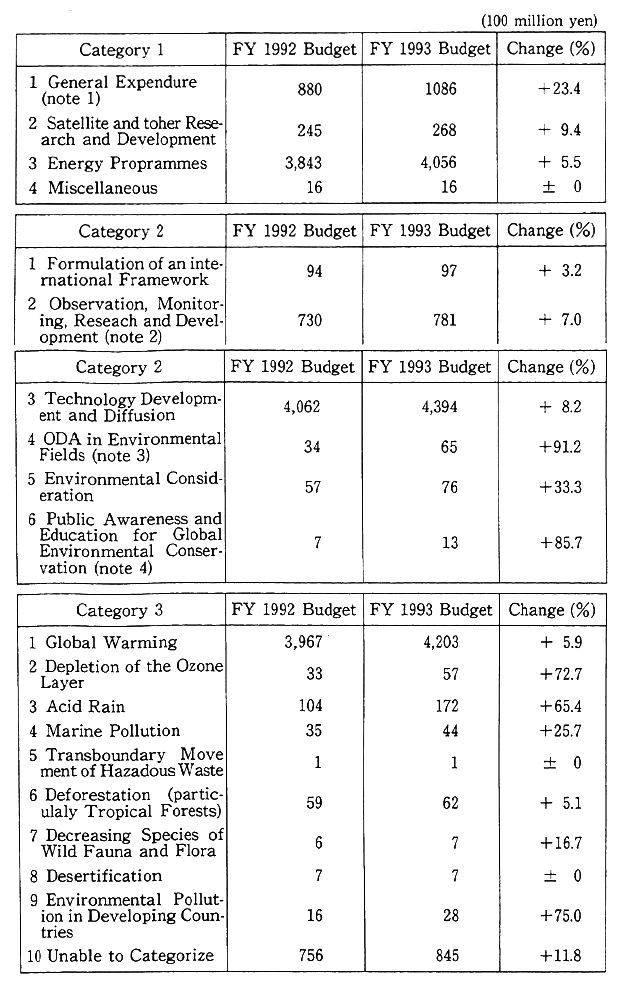
Note: 1. General Expendure consists of international and other organizations, reserches and surveys, ODA in environmental fields and other policy expendures.
Note: 2. "Budget for Promoting and coodination of Science nd Technology" under Science and Technology Agency is not included in this table, as the portions related to global environmental protection cannot be identified exactly.
Note: 3. The grant aid rendered by the Ministry of Foreign Affairs, technical cooperation by Japan International Cooperation Agency (JICA) and soft loan by the Overseas Economic Cooperation Fund (OECF) are not included on this table, as the portions related to global environmental conservation cannot be identified exactly.
Note: 4. In Public Awareness and Education for Global Environmental Protection, actions and projects to make socioeconomic performances less environ-mentally burdensome, for example promotion of resources and energy-saving, are included.
12-1-1 Measures to arrest Global Warming
(1) Outline of Issues
The greenhouse gases in the atmosphere (GO2, CU4, N20, vapor etc.) intercept radiation emitted from surface of the earth, and through this process the earth has been kept at certain level of temperature.
Global warming is the change in climate, which provide basis for mankind and the ecosystem, due to the enhanced greenhouse effect by man-induced increase of CO2 and other greenhouse gases which will cause the temperature of the Earths surface to increase. Predicted global warming has never been observed over the last 10,000 years, the rate of which is characteristically higher in geological term.
According to the report of the Intergovernmental Panel on Climate Change (IPCC), it is projected under the business-as-usual scenario that the global mean temperature would rise by about 1 C by 2025 and about 3 C by the end of the 21st century above the present value, and that global mean sea level would rise by about 20 cm by 2030 and by 65 cm (with a maximum rise of 1 meter) by the end of the 21st century.
(2) Measures
(a) Promotion of the Action Program to Arrest Global Warming
The Council of Ministers for Global Environment Conservation established the Action Program, which set out principles and basic policies to address the global warming, on October 1990. At present, all sorts of measures are implemented according to the Action program.
Main measures which is taken in fiscal year 1992 are shown a follows.
a. Examinations were conducted for the formulation of model programs to implement measures by local governments in line with the Action Program.
b. In waste management, new technologies such as reduction and resource recovery, utilization of incineration heat, recovery of GHG (methane) were positively promoted. And public awareness activities related to reduction, resource recovery and energy recovery are promot- ed.
c. In order to form transport systems with low CO2 emissions, promotion of modal shift in the areas of medium or long distance transport between major terminals, improvement of transport effi- ciency, promotion of the use of public means of transit (in particular, transportation by bus), and developed/improved roads such as intersec- tions and bypasses were implemented.
d. In order to form an energy supply structure with low GHGs emissions, development and utilization of nuclear power premising the assurance of safety, utilization of hydraulic and gesthermal power, the introduction of combined cycle power generation and photovoltaic power generation, and so on were promoted.
e. Research on clarification of phenomena and assessment metho- dologies for impact, observation/monitoring with artificial satellites, and development of observation/monitoring technologies were carried out. For this purpose, the Center for Global Environment research of National Institute for Environmental Studies was expanded and consoli- dated. And the Global Environment Research Progtam Budget was expanded and consolidated.
f. In order to develop technologies to mitigate GHGs emissions, such as advanced technology for new energy and energy conservation, and innovative technologies for CO2 fixation and utilization, research was positively promoted under the Sunshine Project and the Moonlight Project and at the Industrial Technology Research Organization for Global Environment.
g. For the full dissemination of the Action Program to Arrest Global Warming, it was distributed to economic and other related organizations, voters and people in general. It was also disseminated to local governments at conferences and other places. In May 1992, the measures which were implemented by the related ministries and agencies under the Action Program to Arrest Global Warming in fiscal 1991 were compiled.
h. As regards international cooperation, support was given to related institutions. And provisional support to develop response strat- egy against global warming in developing countries of Asian-Pacific region were promoted. In March 1993, the Asian-Pacific Seminar on Climate Change was held in Bangkok. Furthermore, training conducted by private organization were supported in order to promote transfer of technologies which contribute to mitigate global warming.
(b) Response to the Framework Convention on Climate Change
The United Nations Framework Convention on Climate Change was adopted in May 1992, following a total of six sessions of the Intergovernmental Negotiating Committee (the first to fifth sessions and the second part of the fifth session), and Japan signed the conven- tion at the Earth Summit in June of the same year. The country also made a pledge to make efforts to stabilize emissions of carbon dioxide by 2000 to about the 1990 level in accordance with the Action Program to Arrest Global Warming. In March 1993, the Cabinet decided to seek National Diet approval of the convention. The ultimate objective of this convention is to stabilize the concentration of greenhouse gases in the atmosphere, imposing various duties on the parties to it. In particular, the convention requires the developed country parties, including Japan, to adopt policies, take measures, and communicate detailed information on its policies and measures to the conference of the parties with the aim of returning the emissions of greenhouse effect gases to their 1990 levels on the recognition that the return by the end of the present decade to earlier levels of anthropogenic emissions of carbon dioxide and other greenhouse gases would contribute toward the fulfilment of the conven- tion's objective. Under the convention, many issues including matters which will be decided on by the conference of the parties were left to forthcoming international discussions. At the sixth session of the Inter- govemnmental Negotiating Committee, a work plan for the committee was adopted with the purpose of implementing the convention. Further- more, the financial mechanism of the convention was discussed and a new institutional arrangement was determined at the seventh session of the Negotiating Committee held in March 1993.
(c) Intergovernmental Panel on Climate Change (IPCC)
The IPCC was set up by UNEP and WMO in order to study scientific findings on global warming, environmental and socioeconomic impacts and response strategies. The first assessment report was fur- nished to the Fourth session held in August 1990 and at the Seventh session held in February 1992, the supplements to the first assessment report was furnished.
Furthermore, IPCC is currently aiming to produce the second assessment report which will compile and review the latest information on scientific findings by 1995. In order to meet this objective, the eighth plenary session held in November 1992 approved restructuring of its organization.
Japan has been positively involving itself in cooperation with the IPCC and in providing support to activities of the IPCC through active participation to the related meetings as well as serving as deputy chairman of Working Group II.